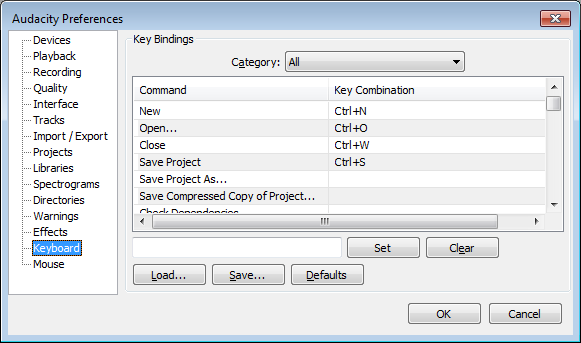Keyboard Preferences
From Audacity Manual
This preferences window sets the keyboard shortcuts which can be used for numerous commands in Audacity as an alternative to using Menus, Toolbars or mouse gestures.
A full list of the commands with their default key bindings is also available at Keyboard Shortcut Reference.
Key Bindings
- Category: Use this popup menu to view: all key bindings; those key bindings associated with a particular menu, or; those key bindings not associated with any menu item (the Command choice).
- Command/Key Combination list:
- These headings list all the commands which can be attached to keyboard shortcuts, together with their currently allocated shortcut or "binding".
When "All" is selected from the Category popup menu the commands are listed in the following order:- Commands associated with the various Menus, listed in the order in which the menus appear (left to right) in the menu bar
(As noted above, you can look at the key bindings associated with a particular menu by choosing the menu name from the Category popup menu) - Commands not associate with any menu:
(You can see just this list of key bindings by choosing "Command" from the Category popup menu)- Cycle through Dock, Track View and Selection Bar
- Tools Toolbar
- Control Toolbar and associated Play commands
- Additional Delete keys
- Seek during playback
- Move and toggle track focus
- Move cursor
- Adjust selection regions
- Track Panel and Track Drop-Down Menu commands for focused track
- Snap To
- Full Screen on/off
- Adjust output gain
- Adjust input gain and source
- Adjust playback speed
- Commands associated with the various Menus, listed in the order in which the menus appear (left to right) in the menu bar
- These headings list all the commands which can be attached to keyboard shortcuts, together with their currently allocated shortcut or "binding".
- Input box and Set button: To change or add a binding:
- Click to select the item you want to change in the Command/Key Combination window. The current key combination for that command (if any) will now appear in the input box to left of the Set button.
- Either click in the input box, or press TAB once to switch focus to it.
- Choose your binding by either holding any command key then pressing any non-command key, or simply press any non-command key. Valid command keys are SHIFT, CTRL (CMND on a Mac) and ALT. As an example, SHIFT+6 or SHIFT+Y are both valid bindings. Your chosen key or key combination will now replace the previous content of the input box.
- Click "Set" to apply your desired change. If your chosen key binding is already allocated to a command, Audacity will inform you and let you enter another binding instead.
- Clear: To remove a binding: select the item as above, then press "Clear".
- Defaults: Clicking this button reverts all bindings to those when you first obtained Audacity. This button is handy if you decide you have not got your changes right and want to start over again. Naturally you can also press "Cancel", in which case all bindings will remain as they were before you started to edit them.
- Save and Load: You can export and import key bindings (for example to keep a safe copy of your custom settings, or to transfer them to Audacity on another machine). "Save..." exports your bindings as an xml file, and "Load..." imports the xml file back again. You can also edit this file in any text editor and re-import it, as an alternative to editing the key bindings in Preferences. Note however that Audacity does not check for bindings which are allocated to more than one command when loading the file, so edit carefully. The only entries you can usefully edit are the actual key bindings themselves which are in the "key" string at the end of each command. For example, to set the key binding for "New" to SHIFT+N, the command in the xml file should read:
<command name="New" label="New" key="Shift+N"/>
Be sure not to delete the closing "/>" characters at the end of the command.


